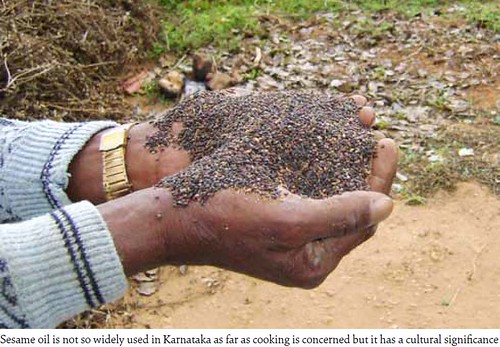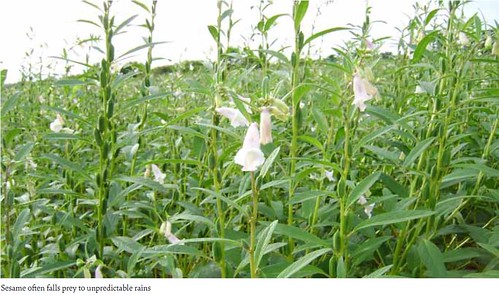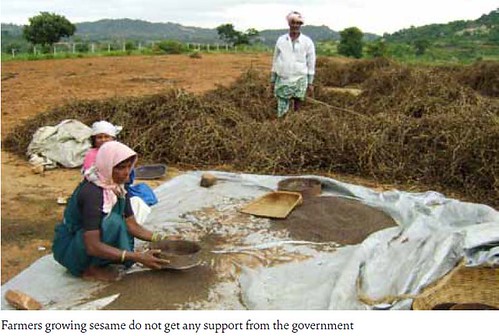Source
Media campaign for climate justice Compilation of monographs from the 2014-15 media project of Pipal Tree
‘Ettu varudam kettavan ellu vidaikkunum.’ This is a saying in Tamil which means that any farmer who is under loss for last eight years must grow sesame; he is assured of somereturns from this crop.
 Sesame is a drought tolerant short duration crop. The crop is harvested in just three months. A farmer can harvest up to 3.5 quintals of sesame from an acre of land and earn Rs.30,000 at the current market price of Rs.9000/quintal. This is an income without much effort.
Sesame is a drought tolerant short duration crop. The crop is harvested in just three months. A farmer can harvest up to 3.5 quintals of sesame from an acre of land and earn Rs.30,000 at the current market price of Rs.9000/quintal. This is an income without much effort.“Growing sesame is very easy”, says Kemppanna, a sesame grower of Bande Marasandra village. “It needs less labor and investment. Sow the seeds, plough the land to cover the seeds with earth, inter-cultivate the crop to avoid weeds, and harvest after three months. No need of spending money on fertilizers and pesticides. Application of fertilizers makes the plant grow luxuriantly but flowering and seed setting will be reduced. Since the plant itself is bitter in taste no pests are attracted to it. The only thing we need is a good rainfall at frequent intervals and less of showers for at least a week to thresh the seeds”, he explains.
Queen of oil seeds
Sesame is scientifically recognized as ‘Sesamum Indicum’ and belongs to the family ‘Pedaliaceae”. In Kannada, Tamil and Malayalam, it is known as ‘Ellu’, ‘Nuvvulu’ in Telugu and ‘Til’ in Hindi. Gingili is the other name of sesame in English. This plant is believed to have originated in the African continent. It is known as the first oil seed plant grown by man. The crop is best suited to tropical climate.
India is the leading producer of sesame followed by China, Sudan, Mexico, Turkey and Pakistan. India accounts for 45% of the sesame grown in the world (62.5 lakh acres). Uttar Pradesh, Rajasthan, Madhya Pradesh, Andhra Pradesh, Maharashtra, Gujarat, Tamil Nadu, Orissa and Karnataka are the major cultivators of sesame.
In the state of Karnataka, Bidar, Dharawad, Gulbarga, Mysore, Raichur and Ramanagara districts are the major growers of sesame covering about 1,00,000 acres and producing about 13,000 tonnes of grains annually.
Sesame is known as the queen of oilseeds because of its superior quality of oil when compared to all other edible oils. Sesame seed contains about 40 to 50 per cent of oils, 20 to 25 per cent of proteins and almost the same quantity of carbohydrates. 100 grams of oil produces about 560 kcal of energy. Sesame oil is pale yellow in color with a pleasant odour similar to that of groundnut. It has about 80 per cent unsaturated Oleic and Linoleic fatty acids which is the highest among edible oils originating from plants.
This helps in cell structure formation, transportation of cholesterol in blood vessels and clotting of blood. Sesame oil is hence advised as a safe food for heart patients.
Sesame oil is used for cooking in Tamil Nadu. In Ayurveda, sesame oil is used to give body massage as it gives good relief from muscle and joint pains and muscle catches. Sesame oil is also used in the manufacturing of scented hair oils, soaps, paints and insecticides. Even the oil cake is rich in carbohydrates, proteins and minerals, and is consumed as food. Since the oil cake is rich in phosphorus and calcium, feeding it to cattle increases the milkyield and its fat content.
Sesame oil is not used for cooking in Karnataka but the seeds are used in different forms in various rituals and to prepare traditional food items like ‘Chigali tambittu’, ‘Kadubu’, ‘ellunde’,‘puliyogare’, ‘vatta kolambu’ or gojju, etc. Sesame seeds are used on the occasion of ‘pitru paksha’, a festival celebrated to remember the ancestors of the family.
Sankranthi festival is also known as ‘ellu beeruva habba’ which means a day reserved for the exchange of sesame seeds, where ellu is mixed with groundnut, fried gram and crystal sugar. Sesame seed is also used during the Diwali festival where the seed is sprinkled over ‘Kajjaya’, a special food made for the occasion.
Puttellu, dry land farmers’ delight
Puttellu is a local variety of sesame specific to Kanakapura, a taluka in Ramanagara district. A study conducted by the University of Agricultural Sciences, Bangalore, has shown thatthis variety gives more stable yield when compared to 50 other strains put under trial. “This variety yields more oil and it has a very good flavor”, says Mohammed Shoukhath, a merchant at the APMC (Agriculture Produce Marketing Committee) yard in Ramanagara. He points out that because of these qualities, oil extractors from Gujarat and Tamil Nadu prefer to come all the way here to buy sesame.
Concern over rainfall
According to Dr. Chennesh, a farmer friendly agricultural scientist, there is not much change in the total rainfall received in the district, but the rainfall distribution pattern has been changed. There is shortage of soil moisture in the sowing season and unseasonal showers during harvesting time. Farmers are not well equipped to cope up with this type of climatic change.
“Sesame is a seasonal crop and can be grown only in early Kharif (April-June)”, explains Shankar who is associated with ‘Green Foundation’, a NGO working on the preservation of crop biodiversity.
Farmers used to forecast an entire season’s rainfall based on ‘Bharani’ rains. The number of days in a year is divided into 27 ‘Nakshatras’ (stars) and each Nakshatra will last for 13 to 14 days. Bharani is one such Nakshatra which begins on 27th April and ends on 11th May every year. There is a saying in Kannada that ‘Bharani male bandre dharani tumbaa bele’ which means that if it rains in Bharani, then that year would assure a good harvest ofcrops. “But we are not sure of this now. Nowadays the Bharani rain has become a rare occurrence and even if it rains, the other rains are highly unpredictable. The climate has totally changed”, says 70 year old Umashankar of Mudenahally village.
The farmers are concerned about the changing rainfall pattern. “The tank of our village is lying dry for the last ten years. We stopped growing sugarcane and paddy due to shortage of water. There is no stored water in the tank even for the cows to drink. Most of our villagers stopped cattle grazing because of this problem”, says Bheemaih (65) of Chikka Sadenahally village. Sadenahally is a small village of about 100 households known for their traditional agriculture and preservation of local cow breeds. The last decade saw Puttellu being grown in this village in about 50 acres of land. The area under cultivation of Puttellu hasbeen gradually decreasing over the years and this year none of the farmers have sown this crop.
 This trend is seen throughout the district. The Agriculture Department data of net sown area of sesame is astounding! During the year 2010 sesame was grown in 14,612 acres. Sincethen it is showing a declining trend.
This trend is seen throughout the district. The Agriculture Department data of net sown area of sesame is astounding! During the year 2010 sesame was grown in 14,612 acres. Sincethen it is showing a declining trend.This year sesame was sown in only 4,425 acres. In the last five years there is reduction of about 70 per cent of the total area under cultivation of sesame. These statistics may not cover the small farmers who grow sesame in a few guntas of land (1 gunta is 1/40th of an acre) for home consumption.
“Earlier I used to take great precaution while grazing in the farmers’ fields because sheep likes the tender sesame crop. But it is not the case now as most of the plots are not sown”, says Ramanna (55), a shepherd from Sira village in Tumkur district who for the last 30 years has been coming every year to the villages of Ramanagara District with his flock.
Devaraj, owner of ‘Manjunatha Provision store’ at Harohally, sold 70 kgs of sesame this year during Ganesha festival season. Most of his customers were from the villages nearby that used to grow sesame in the past. “When I opened my shop in this village about 15 years back, sesame was not kept for sale because there were no buyers at that time. But now everybody buys sesame”, he says.
Curse of Climate Change
Being purely a rain fed crop, this has to be sown in the hot summer before the pre-monsoon showers. Cultivation of this crop becomes difficult if there is any deviation in the rainfall pattern. In other words, this crop will be the first victim of climate change. According to Narayana Reddy, a veteran organic farmer, this crop is almost extinct in Kolar and Chikkaballpura district because of scanty rainfall.
Farmers don’t easily give up cultivation of a crop unless they are completely disillusionedwith the challenges. ‘Bharani’ and ‘Aridhra’ (June 22 to July 6) rains are necessary forthis crop; Bharani for germination of seeds and Aridhra for flowering and seed setting.These are two critical stages for this crop.
Disappearance of winter showers (Jan-Feb) is also affecting the cultivation of this crop. “We need early showers to prepare the land for ploughing. Ploughing helps in the infiltration of water. It also keeps the land ready for sowing. We used to get the first showers during Shivaratri festival (Feb) but not anymore”, explains Puttaswami Gowda of Shivanahalli village. The average rainfall received in Kanakapura during this period was 5.5 mm but rainfall data of last 5 years shows no rainfall.
In Kanakapura the sesame crop is normally harvested in the month of July. Dry weather is needed for drying and winnowing of grains. In recent years the month of July has been cloudy and moist.
Though the expected rainfall of Kanakapura during the month of July is 67 mm, it was 87, 100.2 and 85.8 mms during the years 2011, 2012 and 2013 respectively. After studying the rainfall pattern for the last decade, Mr. Raje Gowda of the University of Agricultural Sciences, Bangalore concluded that there is a shift in the monsoon showers.
Earlier, peak months for rainfall were May, June and August but now it has changed to May, July and September. This changed rainfall pattern is disturbing the post harvest operations of the sesame crop.
Other factors contributing to the decline of sesame cultivation
The number of bullocks in the villages has been diminishing. Ploughing by tractors is quite expensive for small farmers. Even if they are ready to hire, smaller plots are not preferred by the tractor owners who demand a higher rate for the work. Paying high prices for ploughing is a risk factor at this stage since there is no assurance of further rains. Since the climate is hot and the sunshine is bright during these months, the soil dries up fast and becomes hard quickly making it difficult to plough.
 “Nowadays, farmers are applying more fertilizers even for finger millet. While sowing they apply DAP and once again top dress them with Urea during tilling. This affects the water holding capacity of the soil making the top soil very hard and impossible to plough if there is not sufficient rain”, points out Shivaraju of Sheetalavadi village. He has given up sesame cultivation since the last five years. Farmers are not applying sufficient quantity of farmyard manure on finger millet plots as there are not enough cattle to produce the manure. One tractor load of manure costs about Rs. 3000 which is far too expensive for small farmers.
“Nowadays, farmers are applying more fertilizers even for finger millet. While sowing they apply DAP and once again top dress them with Urea during tilling. This affects the water holding capacity of the soil making the top soil very hard and impossible to plough if there is not sufficient rain”, points out Shivaraju of Sheetalavadi village. He has given up sesame cultivation since the last five years. Farmers are not applying sufficient quantity of farmyard manure on finger millet plots as there are not enough cattle to produce the manure. One tractor load of manure costs about Rs. 3000 which is far too expensive for small farmers.“Due to lesser organic matter content in the soil, the percolation of water into the soil is reduced”, states Ramaiah (65), organic farmer from Kulume Bheemasandra village. The normal practice is to grow sesame in the plots where finger millet was grown in the previous year. Sesame grows well only if the soil is enriched with organic matter.
The government policies are also not in favor of this crop. There is no subsidy or any other financial benefits for the farmers cultivating this crop. “There is no crop insurance package for sesame. Only marketing facility is provided in the APMC yards”, says Timme Gowda.
British climate economist, Nicholas Stern, warns that “The impact of global warming will be evident with the onset of monsoon rains in the Indian continent. The amount of rainfallreceived and its distribution will show drastic changes in the coming years. Due to this, a situation will arise wherein farmers may not be able to grow certain seasonal crops. Such crops may gradually disappear from that location.”
This sounds true for sesame cultivation in Ramanagara district.
References
1. Bhardwaj R.K, Advances in oilseed research, Oxford book company, Jaipur, 2009, Pages 14-18
2. D M Hegde, Vegetable oils scenario – Approaches to meet the growing demands, Publisher Indian Society of Oil Research,Hyderabad,2009, Pages 247-255
3. Pre-monsoon rainfall & Agriculture situation in Karnataka-2001. Published by Drought monitoring cell, Bangalore.
4. Sesame oil - Wikipedia, the free encyclopedia, 1st September 2014
5. State agriculture profile—Karnataka, Published by Karnataka State Agriculture Department, 2013
Ganapathi Bhat can be contacted at ganapathibhat2011@gmail.com


